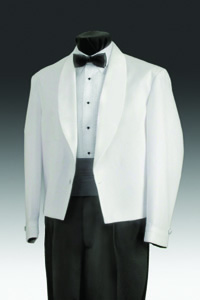|
In the mid 15th century, Henry VI, the scholar king, firmly established the English educational system. One of its most notable schools was Eton College (Eton pronounced like cretin, not like futon). Located on the Thames River in southeast London and across from Windsor Castle, some of the most accomplished Britons in history have been educated there, including the Duke of Wellington, author Percy Bysshe Shelley and Prime Minister Sir Robert Walpole. Despite the presence of several fine English academic institutions, Eton stands above the rest in many categories, particularly in terms of its uniform. Believe it or not, the precursor to the Eton jacket was the medieval monks robe. Originally, children in public schools which were actually fee-paying private schools wore their own clothing paid for by their families. The charity schools, whose students were comprised of children from hospitals, orphanages and the streets, were filled with ragamuffins who had nothing to wear. The clergy provided them with cassocks from the monasteries that not only kept the children warm but visually eliminated the boys economic differences. Females were not a part of this equation because they were not given formal schooling until more recent times. Ironically, as England became more prosperous and powerful, the upper classes found themselves with elitist schoolboys who had become arrogant and unruly bullies. By the 19th century, in the interest of greater discipline, decorum and financial equanimity, the notion of also putting the public school students in uniform was instituted. At Eton, the waistcoat, shirt and now-famous collar, short jacket, and accessories were introduced. College in England refers to secondary school education. Initially at Eton College, the junior class members (also presumed to be those boys who were less than 5 feet 4 inches tall) were made to wear the all-around short jacket while the older classmates wore the longer morning coat that was waist length in front with tails behind. However, there were two problems with the two-coat system: first, there were many upperclassmen who were too short and as a result were not allowed to wear the more adult waistcoat even though they were seniors, and second, the longer waistcoat with its tails that covered ones rear end was a lot warmer than the skimpy junior-level jacket that had become known as the bum freezer. Ultimately, the early 20th century solution was to eliminate the short Eton jacket so all the boys wore a single outfit of the morning coat or waistcoat with the now-famous look of the collar, vest, top hat and tie. Recently, princes William and Harry wore the required Eton outfit. Interestingly, outside the college, the Eton suit with the shorter jacket became the standard for boys of all ages in English society, and the fashion spread to the United States as well. Several of the English colleges had similar uniforms; but it was Etons (rather than Harrows, for example) that caught on. There is no one designer for the specific Eton jacket uniform; the question of the short jackets evolution is bound up with the history of the garment, the styling of a short formal jacket and the name of the college. Similar garments were worn throughout Europe once pants became the preferred mode of mens dress. As a particular garment, the modern Eton jacket oftentimes referred to with a lowercase e because of its distance from Eton College became a part of the regimented repertoire for military dress, cruise ships, hotels, special groups and clubs, and even for assistants such as waiters, butlers and doormen in private homes or restaurants. With ever-increasing affluence, particularly in Western culture, the Eton jacket found its place in more formal society and became a sign of class distinction. Interestingly, worn by both the working classes that served the upper classes and by the upper classes themselves, the degree of hierarchy was identified only by a particular jackets trim; the basic style remained unaltered. During the latter part of the 20th century, couturier designers even presented the Eton jacket with a skirt as a smartly tailored suit for well-to-do women. Today, we in the uniform industry find our customers wanting Etons, many of them not knowing what they are or how an Eton is defined, other than as a short jacket that is at once formal but utilitarian. Etons now can be simple one button or a chain-link two button. They can be double-breasted or single, with two buttons or three. Some have built-in false vestees, while others have false cummerbunds attached. They come lined or unlined with various types of collars, contrasting or self lapels, with pockets or without. There are braid, epaulets, shoulder straps, chevrons and even scalloped yokes for western wear. There is the West Point jacket, which is a military stand-collar version of the Eton. Some Etons have pointed bottoms, some have rounded edges, and some are squared off. They come in all sorts of designs and fabrics including polyester, poly/wool, wool and even poly/cotton or brocades. But the basic style is still the same. It is the short jacket, a waistcoat without the tails, used for the original purposes of identity, deportment and uniformity, that was chosen by the headmasters at Eton College all those years ago. Debra Hindlemann Webster is owner of Custom Uniform Co., a manufacturer of high-quality, American-made custom uniforms. The company has been serving individuals, groups, theme parks, corporations, offices, military, hospitality, entertainment centers and many other businesses with unique custom apparel for more than 70 years. Visit www.customuniformcompany.com or email [email protected] to learn more.
|
| Above story first appeared in MADE TO MEASURE Magazine, Spring & Summer 2008 issue. All rights reserved. Photos appear by special permission. |
| Halper Publishing Company 210 Skokie Valley Road, Suite #4 Highland Park, IL 60035 (877) 415-3300 Fax (847) 780-2902 [email protected] |











